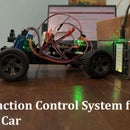Introduction: Ion Thruster
Ionic thruster by name seems like very futuristic and complex technology, but it is not at all difficult to make and demonstrate small thruster at home. But using it for an actual application (like satellite propulsion) is difficult. So in this instructable working of the thruster is explained and a simple thruster is also made.
Step 1: How It Works:
Thrust due to high voltage is results of corona discharge that creates ionic wind which gives thrust. At the conductor having high enough electric field ionize gases. the cloud of Ions are generated in which ions have the similar type of charge (positive or negative), then expands due to high repulsive forces in between. it can be observed from the video that gases try to fly away from both of the electrodes (irrespective of positive or negative).
In below image one setup is shown, where air gets ionized by anode and ions are accelerated toward the cathode that creates ionic wind.
This type of technology can be very useful in satellite propulsion as solar energy can be used to create corona. A very obvious question that arises is that there is no air in space that can be accelerated to get thrust. So these satellite carries gas that can be accelerated using electrical energy. Generally, noble gases (mostly xenon) are used so its other components can react to it. Typically these type of engine can create few mN of thrust while some technology able to provide thrust in term of N. This thrust are obviously not enough to launch rocket bit can be useful for satellite propulsion. Where small thrust for a long time can be the effective solution for trajectory corrections. There is also the concept that used atmosphere air (low-density air) for low orbit satellite.
All these aspects of the ionic engine are very well covered by the following video:
Image: https://www.electronics-cooling.com/2012/03/ionic-winds-a-new-frontier-for-air-cooling/
Step 2: Making
Here whatever ion thruster we are trying to make is really basic and simple one. Some YouTubers has tried some very good machine that hovers (almost) using ionic thruster links are there at the end of the article.
To make the Ionic thruster you will require some high voltage sources like the Tesla coil, induction coil, automotive ignition coil with a driver, etc. here I am using a module that is capable of providing around 40kV of voltage. It is a cheap module available on hobby market is commonly known as 3.7V-6V to 400kV Dc step up power module and costs around 200-300 INR (4-5 USD). This module simply needs to connect with 3.7-6V and output of a few kV can be obtained depending upon the air gap.
In the image, a wire is bend is such a way that it ends are tangential to the center of it. aluminum foil is also wrapped around such that it can be placed on the electrode. This rotor is then placed on a wire connected to high voltage power supply. ionic wind is created at the end of the wire, that produces thrust and apply torque to the rotor. So whenever power is turned on this rotor will start rotating.
Step 3: Other Resources:
As already explained this is a very simple type of thruster for demo purpose, in below link better type of thruster was prepared and tested:
1. A device that hovers using ionic thrust:
2. A good project by makezin :
3. Wikipedia page has interesting details: https://en.wikipedia.org/wiki/Ion_thruster













